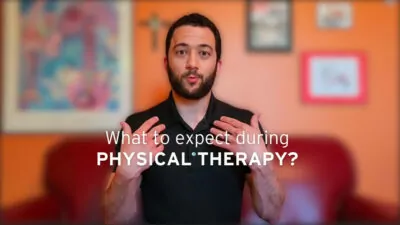
What to Expect During Vestibular Physical Therapy?
Are you dealing with vertigo or dizziness and wondering what to expect at a vestibular physical therapy appointment? In this video, Dr. Anthony Veglia, DPT, provides a detailed overview of a typical visit for those experiencing vestibular disorders. Learn what happens during your sessions and how your therapist will tailor a treatment plan to your specific needs. If you’re searching for relief from vertigo, this guide will help you feel prepared and informed about your upcoming physical therapy appointment.
For help finding a vestibular healthcare provider visit VeDA’s Directory.
TRANSCRIPT
VeDA uses otter.ai to create machine-generated transcripts. This transcript may contain errors.
Hi, I’m Dr. Anthony Veglia, a PT who exclusively treats patients with dizziness, imbalance and vertigo. So let’s say that you’re scheduled for your very first visit with a PT for Vestibular rehabilitation. What should you expect from this first day? It’s kind of a unique area of PT. Well, this is going to depend quite a bit on your diagnosis and your personal goals, of course. But here’s a general outline of what a first visit with me would look like. First, let’s just talk. You are the only person who knows exactly what your symptoms feel like. So even though I probably have some of your history already and some test results, I need to hear it from you. When did it begin? What does it feel like to you? What does it get in the way of what are we working towards, that really matters, and for diagnoses with dizziness and imbalance, I’m going to be taking a nice stylish safety belt right around your waist. I’m going to be hanging on for safety. But we’re going to test your balance. We’re going to see how you handle head movements or complex visuals If that’s a problem for you. But like I said, this is always going to be through the lens of what you need. A 75 year old patient with Ramsay hunt syndrome, who just wants to feel safe driving again. Or I have a patient who’s 18. She’s trying to qualify for the Olympics in artistic swimming, they’re going to be a pretty different levels of intensity. But no matter who you are, you will be challenged on your first day. My job is to find your limits where they are today. And as we continue with therapy, we’re going to push your limits Higher, higher until they’re where they used to be. So come dressed, ready to move. Maybe have some good shoes on too. I have had patients show up to therapy with stilettos on for their first visit. Not great for bats. But during all these tests, if you’re feeling extra dizzy, let’s take a break. If the legs are getting shaky, let’s sit down for a bit. No worries, that’s not unusual. That’s what we’re here to do. Plus, that’s all we need to find out. But by the end of your first visit, I want you to know your diagnosis, know what we’re going to do about a ticket better. And I want you to have some homework to get better. Personally, I never give more than two or three exercises 510 minutes a day. And I always make a printout. So you don’t have to remember a single thing. That is an evaluation for most Vestibular problems. But there’s one big exception positional vertigo. Despite BPPV being the most common Vestibular disorder, it’s treated totally uniquely to compared to other Dizzy issues. To get rid of positional vertigo, you have to go into vertigo. But there are a lot of tricks to make it as tolerable as possible. Come prepared for those symptoms, get dressed so that you can lay down rollover be on your stomach on your back. And depending on your personal symptoms, maybe don’t have a big meal beforehand. Many of my patients leave BPPV treatment feeling pretty good. Maybe a quarter or so really need to take it easy that day. But luckily, most BPPV is totally resolved in just one or two visits. So to summarize, your first day should be challenging, you’ll have your symptoms tested, but safety is absolutely going to be emphasized. But the process of Vestibular rehab and really physical therapy and just exercise as a whole. It’s all about challenging your limits in a controlled manner and progressing more and more until you reach those goals. So stick through it, it really does help. You’re gonna get your muscles burning to get stronger, you’re gonna get out of breath with a run to gain endurance. You’re gonna get dizzy or off balance to improve dizziness and balance later. If you need information on specific Vestibular diagnoses or concepts about dizziness and balance as a whole. Check out the many resources on VITAS website where you can watch some of my own personal videos on YouTube with Dizzy therapy. God bless you on your first appointment to getting back to stability.
